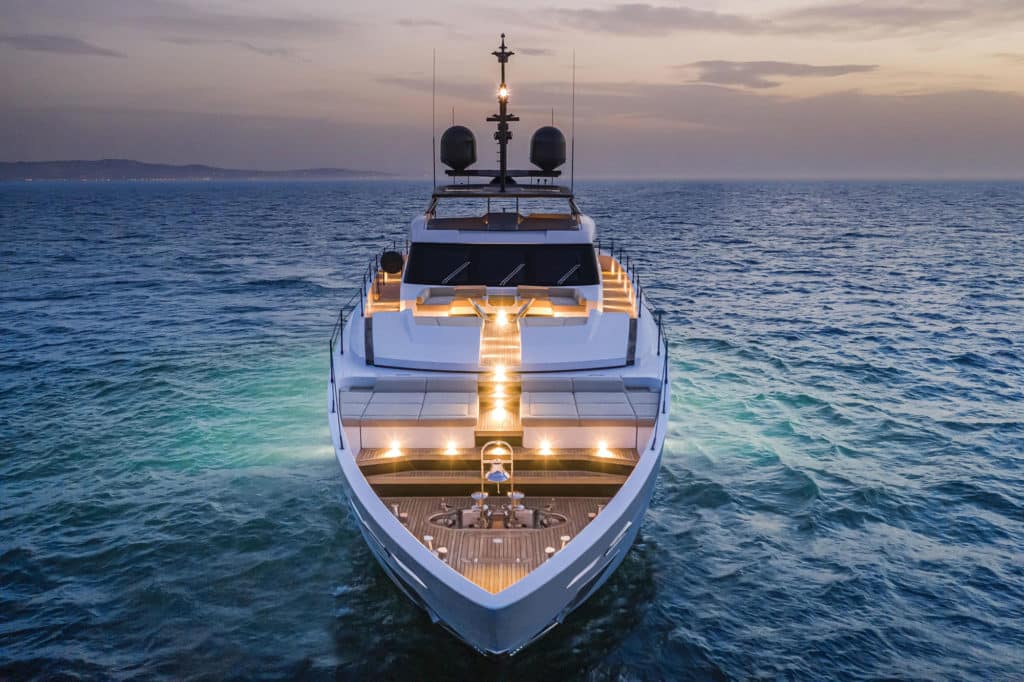
World-class boat shows such as the annual Fort Lauderdale International Boat Show are visual feasts. But as stunning as the daytime optics might be when the docks are populated with billions of dollars’ worth of floating aluminum, fiberglass and carbon fiber, it’s even more visually arresting after the sun sets, both above and below their waterlines. And while there’s no question that proper LED lighting makes otherwise-dark salons and swimming waters significantly more inviting, creating and maintaining these warm and welcoming lumens takes effort.
Now, thanks to Lumishore’s Command Center, creating the right above- or below-water ambiance is about as taxing as tapping a touchscreen display.
While LED lighting has satisfied onboard illumination needs since the mid-2000s, these low-draw installations are typically independent and controlled at the individual light via a dedicated switch at the yacht’s electrical panel (or, depending on the vessel, its digital-switching system), where each grouping (e.g., “running lights”) usually resides on its own breaker.
Although effective, these switches typically don’t allow users to customize a light’s displayed colors without swapping out bulbs. Lumishore’s intuitive Command Center is a game-changing solution for controlling all compatible onboard and underwater lights—including tuning colors and initiating effects such as strobes, sweeps and Lumishore’s proprietary “Sound-to-Light” mode—using smart devices and either a compatible multi-function display and/or Lumishore’s dedicated touchscreen display.
At the core of Lumishore’s digital controls is the Lumi-Link Command Center, which is a black-box module that delivers a browser-based Application Programming Interface for controlling Lumishore’s EOS underwater lights and the company’s new above-the-waterline Lux Lighting Collection systems. An Ethernet port is fitted to one end of the rectangular Command Center, allowing the device to be networked to an MFD and/or Lumishore display, while its other end has three hard-wired connections that go to the networked lights, or—configuration depending—downstream hubs (e.g., waterproof junction boxes), drivers or networking modules. Each Lumi-Link Command Center ($880) also features an SD card slot that enables future software upgrades.
The Command Center also houses a powerful processor and the API that controls all onboard and below-water lighting. “The Command Center is the brains of the operations,” says Chris Myers, Lumishore’s sales director for the Americas. “It’s got the processing power of a large computer.”
Networked MFDs and dedicated Lumishore displays access and control the API via their hard-wired Ethernet connections, and thanks to these latter devices’ built-in Wi-Fi capabilities, in turn, wirelessly share this control with networked smart devices that connect directly with the API via a web browser.
As mentioned, the Command Center can either be networked to a compatible MFD (see Lumishore’s website for details) and/or to a dedicated Lumishore EOS STV 2204-i display ($400). This sleek-looking glass‑bridge display features a rotary dial and a 3.5-inch color touchscreen that runs the same Lumishore-built graphical user interface that users would otherwise access on their networked MFDs or smart devices.
The display’s interface lets users choose their favorite color palettes (this requires Lumishore’s full-color lights), create color presets, set user preferences and select preprogrammed lighting modes; however, it doesn’t deliver any additional functionality over an MFD or wireless device. “It acts, looks and works the same,” Myers says of the Command Center’s intentionally mirrored cross-platform GUI, adding that while “it can sometimes be tricky to [run the GUI] on a little [smartphone] screen, it’s easy to run it on a 24-inch Garmin MFD.”
Lumishore makes three types of underwater lights, including single-color lights that can be controlled using a standard switch; dual-color lights that typically use a hub and a Lumishore switch and can be controlled from an MFD, which requires an additional Lumi-Link Bridge Module; and full-color lights that require a Lumishore Command Center, an EOS STV 2204-i display and/or a compatible MFD.
These luminescent offerings are available in a variety of through-hull and surface-mounted configurations, and—for the superyacht crowd—welded-in housings.
“To have a successful lighting system, you need really good hardware and software,” Myers explains, adding that “one can’t outshine the other and be successful.”
This also holds true for above-water lighting, and Lumishore’s new Lux Lighting solutions deliver the company’s same LED solutions to courtesy-, down- and strip-lighting applications.
Aside from building complimentary software and hardware, other factors such as beam angles also play significant roles in determining success, especially below the waterline. Myers explains that beam angles are a bit like placing one’s thumb over a garden hose.
“If you go with a wider angle, you won’t get as far a spread for the same water flow,” he says, adding that after much (ongoing) R&D, Lumishore chose 60-, 90-, and 110-degree beam angles. “We tried to find the best effects that we could.”
As for differentiating one’s yacht in a target-rich environment such as the Fort Lauderdale International Boat Show, it isn’t easy—given some of the skylines and waterlines involved. However, Lumishore’s Sound-to-Light feature, which displays colors based on music’s unique highs and lows, could deliver the right edge. Provided, of course, that one’s musical tastes are up to snuff.




